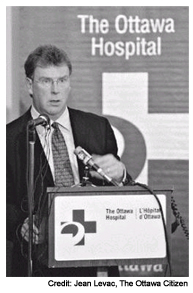Newsroom
In The News
Quick CPR treatment saves heart attack victims study
Norma Greenaway
The Ottawa Citizen
August 12, 2004
 Scientist Richard Snell is living proof a newly released Canadian study is right when it says hundreds of victims of sudden cardiac arrest could be saved if more bystanders jumped in and performed CPR.
Scientist Richard Snell is living proof a newly released Canadian study is right when it says hundreds of victims of sudden cardiac arrest could be saved if more bystanders jumped in and performed CPR.
Mr. Snell owes his life to a Montreal stranger who dug deep in his memory last May and successfully put into practice CPR training he had taken two decades earlier.
Mr. Snell, 49, had collapsed on a Montreal street while rushing to catch a train back to Ottawa, and in what he admits was astounding good luck, three passersby recognized he was suffering cardiac arrest.Within seconds, one was administering CPR (cardiopulmonary resuscitation). "Without him, I'd be dead," Mr. Snell said yesterday, acknowledging the grim survival rate of five per cent among the estimated 25,000 to 30,000 Canadians who suffer cardiac arrest each year outside of a hospital.
The Ottawa resident told his story as researchers released their study results.
It's the first major study showing the chances of surviving a cardiac arrest improve significantly if the victim gets speedy CPR from a bystander. The 10-year study was based on the experiences of 5,638 people in 17 urban Ontario centres who suffered cardiac arrest outside a hospital.
The study, which appears today in the New England Journal of Medicine, says the immediate application of CPR allows the person to survive long enough to benefit from defibrillation -- an electric shock to the heart --and advanced life support measures that paramedics can deliver before they get to the hospital.
The major finding says a victim is 3.7 times more likely to survive a cardiac arrest if he or she gets immediate CPR.
Principal researcher Ian Stiell, an emergency room physician and teacher affiliated with the Ottawa Hospital, said the study illustrates beyond doubt the procedure using a combination of hands and mouth is as critical to saving lives as any sophisticated machine.
The problem is that only 15 per cent of cardiac arrest victims benefit from bystander CPR, the report said. The rest of the victims had to wait to get CPR from firemen, police or paramedics.
Mr. Stiell told a news conference that just doubling the rate of CPR administered by citizens would save 350 lives a year in Ontario alone.
Mr. Stiell told a news conference he hopes governments will respond to the study by pumping significantly more resources into CPR training for ordinary Canadians.
"There is no question that we need to focus and promote and expand CPR training," Mr. Stiell said, adding that a prime target should be the families of cardiac patients.
The study also showed the survival rate improves significantly if defibrillation is applied within eight minutes of the heart stopping beating, something Mr. Stiell cited as proof the rapid availability of defibrillation equipment should be a priority as well. The survival rate is 3.4 times greater if rapid defibrillation is administered, the study said.
Contrary to popular opinion, however, the research says the survival rate among cardiac arrest victims does not improve with the addition of advanced life support interventions, including such things as advanced airway management (endotrachea intubation) and intravenous drug therapy, administered by paramedics.
Ian Stiell, the study's principal researcher, says the use of the hands and mouth procedure is as critical to saving lives as any type of sophisticated machine might be.
In short, Mr. Stiell argued, it is too late for the more sophisticated treatments if the patient has not been kept alive by CPR and rapid defibrillation.
He stressed, however, that advanced life support interventions by paramedics do play a significant role in the survival rate among people who suffer from such other ailments as chest pain or respiratory stress.
The study credits many communities with expanding the availability of defibrillation equipment, placing automated machines in arenas, shopping malls, public pools and theatres. But Mr. Stiell says their usefulness is limited because 85 per cent of cardiac arrests occur in residential setting.
The findings are the latest installment in a three-phased study, known as the Ontario Prehospital Advanced Life Support study, which was commissioned by the Ontario government to help assess budget requests revolving around emergency medical services.
Mr. Snell calls the low survival statistics "mind-boggling" and said in an interview he still can't believe his luck at being spotted by someone who had CPR training when he collapsed in May.
Mr. Snell, who had CPR training under his belt when he collapsed, says it's a shame more people do not spend the four hours it takes to learn the technique.
"What happens if somebody in the house collapses? Everybody stands around. They're upset. They are saying: 'Where are the paramedics?' And when 10 or 15 minutes go by, it's too late."
© The Ottawa Citizen 2004
